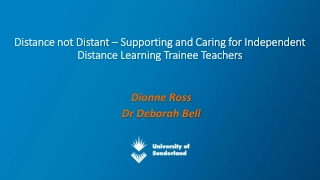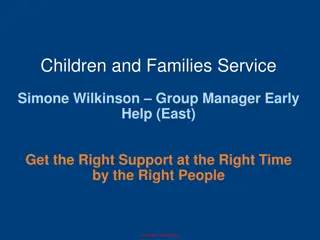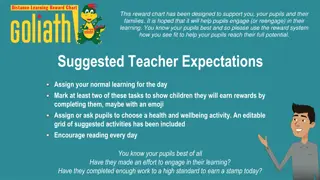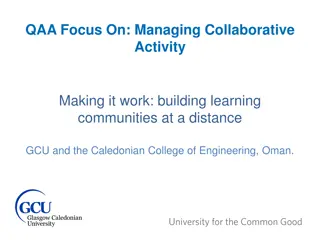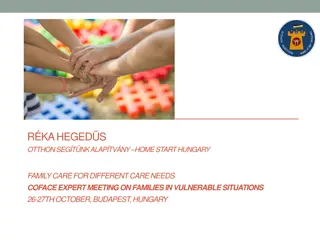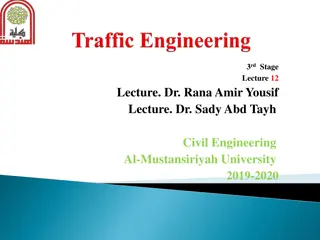Supporting Families Through Distance Learning Challenges
Strengths, challenges, and strategies for navigating the complexities of distance learning, including supporting children's emotional well-being, addressing family dynamics, understanding trauma, and fostering hope amid the pandemic. Expert insights from a clinical psychologist offer guidance on resilience, communication, and prioritizing mental health during these challenging times.
Download Presentation

Please find below an Image/Link to download the presentation.
The content on the website is provided AS IS for your information and personal use only. It may not be sold, licensed, or shared on other websites without obtaining consent from the author. Download presentation by click this link. If you encounter any issues during the download, it is possible that the publisher has removed the file from their server.
E N D
Presentation Transcript
EMOTIONAL SUPPORT DURING DISTANCE LEARNING Jodi Couick, Ph.D., Clinical Psychologist WCCUSD SPED Director-Educationally Related Mental Health Services
STRENGTHS & RESILIENCY You are the experts on your children, what they need, and their unique communication styles You and your family navigate stressful events daily at a high level Pivot is a new term we have been using but We educators are relying on you more than ever And will continue to when we return Maybe Silver lining, continued collaboration and teamwork
CHALLENGES Multiple family members at Home with different and often conflicting needs Extra Stimulation, challenges with finding space and quiet areas Lack of structure and routine of school, scheduling issues Need for so much more supervision, lack of caregiver breaks Social Isolation (sometimes gaming community is a supportive connection) Anxiety, Depression, Fatigue and hopelessness
MASLOWS HIERACHY OF NEEDS We all really have two brains: the learning brain and the survival brain. Survival Brain-Flight/Fight School Closure created chaos for even the most structured family units Rules and Routines help in calming the survival brain and forming space for the learning brain to function.
LAYERS OF TRAUMA NEED TO HELP Our Kids HOLD ONTO HOPE. Hopelessness is a major sign students are struggling with their mental health, and it can manifest verbally or nonverbally. ANXIETY IS A COMMON RESPONSE TO THE UNKNOWN/UNCERTAINTY ANXIETY CAN GO VIRAL STEALTH ANXIETY-LAYERS WE MIGHT NOT EVEN BE AWARE OF
PEDDLERS OF HOPE Sometimes we have to be the example to show our children they can make it through these situations and there is light on the other side of the tunnel. Often your strength can come from family concepts related to hope, faith, spirituality, and cultural mottos. Challenge when access to extended family and friends is limited right now. Parent s grief and anxiety affects childs-even if they don t have the words or understanding for it. So, how to plan for this, where is your respite at home?
PANDEMIC AS A TRAUMA The combination of fear, cabin-fever, social isolation, and Zoom Fatigue has left all members of the school community more vulnerable. The COVID-19 pandemic has given rise to a collective, mass trauma. People with reasonably good coping skills and who have the ability to self-regulate, are struggling, so perhaps it goes without saying that individuals who were already more vulnerable, including people with autism spectrum disorder (ASD), are particularly impacted by this crisis.
ADUSTMENT TO TRAUMA Many students with special need already have challenges communicating their wants and needs, so an increase in behavioral expression can be expected. Since trauma causes difficulty with self-regulation, hyper-vigilance, and changes in cognitive ability and introspection (already a challenge for many students on the spectrum), we can expect more emotional outbursts, more fearfulness, increased engagement in restricted interests, increased perseveration, and increased problems with verbalizing emotions and needs. On the other hand, some students may respond with hypo-arousal, appearing passive and detached from learning and social interactions.
ROUTINES Maintaining Routines: Many individuals with special needs cope best when daily routines are only minimally interrupted or altered. Routines provide increased comfort and are of even more importance during times of stress. Routines are one of the best tools for combatting anxiety and worry. Even with COVID-19 restrictions, there are some daily routines that do not need to be changed. For example: - Sleep/wake times and routines - Hygiene routines - Household chore routines - Meal times and routines Entertainment routines
YOU PROBABLY HAVE DONE THIS Creating New Routines: It will most likely be necessary to create some new routines in order to accommodate remote learning, curfews, social distancing and other COVID-19 related changes. Some examples of potential new routine may be: Screen time use and transitions: This does not include screen time used for remote education, telehealth, or socialization. Establish clear boundaries, expectations and rules relating to screen time and use. Include screen time in the student s daily (visual) schedule. The activity following screen time should never be an undesirable activity. Use a visual timer
VISUAL SCHEDULES Daily schedules: Structuring the student s day ahead of time is a highly effective way to help reduce anxiety associated with ambiguity. This is even more important when changes beyond our control continue to shift each day. Structure provides the student with a sense of boundary and control . When creating new routines/schedules remember to include the student in the planning process as much as possible. When possible, offer them choices for activities, as well as the time frame in which they would like to complete something (e.g., would you like to do math during morning academics or after lunch?). Evening or Weekly family talk time (family meetings) might be a good time to review and revise, especially after unpredictable melt downs.
PROMOTING POSITIVE SOCIAL CONNECTEDNESS Build in scheduled daily opportunities for social connectedness. Create a list of family members, peers, professionals, etc. with whom the student can schedule times to meet with via zoom or FaceTo,e formats. Telephone calls and texting are other possible avenues for connecting. However, being able to see the other person increases the social connectedness and has been shown to decrease feelings of isolation and loneliness.
Monitor Behavioral Change Many of our students struggle with, and may not be able to, verbally express their feelings relating to the ongoing changes. Sometimes these emotions may be expressed via behavioral changes or shifts. You know your child best. You have the most intimate knowledge of your child s behavioral baseline and will be best able to detect even the slightest of changes Some behavioral changes that may be indicative of anxiety or depression to be on the lookout for may include: - Changes in sleep and or eating patterns. Possible nightmares -Excessive worry or ruminations Increased clinginess or withdrawal/decreased engagement in highly desired activities - Increased agitation or irritability - - Increased meltdowns - Increased tantrums - Increased perseverative behaviors - Regression
PARENTAL ANXIETY/STRESS Witnessing a parent in a state of anxiety can be more than just momentarily unsettling for children. Kids look to their parents for information about how to interpret ambiguous situations; if a parent seems consistently anxious and fearful, the child will determine that a variety of scenarios are unsafe. And there is evidence that children of anxious parents are more likely to exhibit anxiety themselves, a probable combination of genetic risk factors and learned behaviors. It can be painful to think that, despite your best intentions, you may find yourself transmitting your own stress to your child. But if you are dealing with anxiety and start to notice your child exhibiting anxious behaviors, the first important thing is not to get bogged down by guilt. It feels really bad to have anxiety, and it s not easy to turn off.
SELF-CARE (SERIOUSLY!) Daily me time: 15 30 minutes Carve out even just 15 minutes every day or so to do something that is relaxing. Whether it s reading a magazine, listening to music, or talking on the phone to a friend, it s super important that parents have a me moment i order to recharge, reset and rally for the next challenges, Set a visual timer for family if needed. Simplify common chores and gift yourself time back (e.g., dinner preparation) Embrace movement: -enough about exercise already, just dance like no one is watching or do a walking errand Find your tribe: Most of you have done this, but it may be time to expand your bubble. Get respite. Squeaky wheel gets the grease-even during the pandemic.
HOW TO DEAL WITH OUR OWN ANXIETY Model stress tolerance If, for example, you are working on thinking rationally during times of stress, you can practice those same skills with your child. Say to her: I understand that you are scared, but what are the chances something scary is actually going to happen? Explain your anxiety While you don t want your child to witness every anxious moment you experience, you do not have to constantly suppress your emotions. It s okay and even healthy for children to see their parents cope with stress every now and then, but you want to explain why you reacted in the way that you did.
WHAT TO DO (AND NOT DO) WHEN CHILDREN ARE ANXIOUS Respect feelings without empowering fears The goal isn t to eliminate anxiety, but to help a child manage it Don t avoid things just because they make a child anxious. Express positive but realistic expectations. Respect her feelings, but don t empower them. The message you want to send is, I know you re scared, and that s okay, and I m here, and I m going to help you get through this. Encourage the child to tolerate her anxiety. Think things through with the child. It is important to remember at a time like this that anxiety is a normal and protective human emotion that serves an evolutionary, survival function-fight-flight response By design, anxiety is higher when the threat is different from any we ve experienced before.
DEALING WITH ANXIETY Limit exposure to media coverage, both in terms of time spent per day and who you choose to listen to. Tune in to only one or two trusted sources (e.g., the CDC, a state medical official). Shield younger children from the news altogether; for older children and adolescents, watch together so you can explain and discuss what is presented. Monitor adult conversations in front of children and adolescents to protect them from additional worries over which they have no control (e.g. family finances). Remember that this is temporary, although timeframes for a return to normal remain unclear.



